Frogs and their colors have always intrigued us, and social media is a witness to its users going crazy over the different color shades of these amphibians. With crazy frog colors popping up each day, you need to know the facts.
So, what colors do frogs actually have? Frogs come in three primary colors: green, brown, and gray, with toads primarily being gray. Other color shades include yellow, red, and black, and some rare tropical frogs or toads that come in different shades.
What do these colors symbolize, and how do these little amphibians come in so many varying colors? We will answer all of that for you in this article, so hop in as we uncover the mysteries of frogs and their colors.
Frogs Have Different Colors Based On Their Environment
Frogs or toads get their colors based on their natural habitats. This has mainly happened through evolution resulting from various ecological factors. The little hoppers’ bodies have mirrored the environment, allowing them to camouflage when threatened by other predatory species.
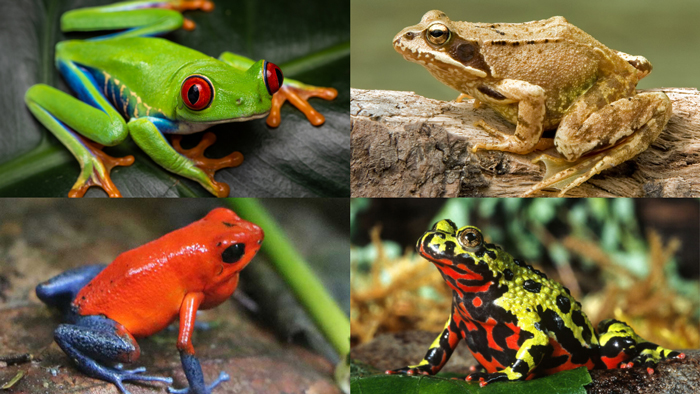
For example, frogs that are green in color are often found in locations that have an abundance of greenery. This allows them to mix with the trees and prevent them from getting hunted down.
Other than that, toads also have textures on their skin other than their color, which aids in hiding. Toads that reside in rocky areas have warts that help them to camouflage better.
Some frogs exhibit the opposite by having bright colors and hues to warn other animals of the toxins they contain. This occurrence in toxic frogs is known as aposematism. In some cases, the color of a toad’s skin can change to help it cope with the temperature of its habitat.
Below, we will discuss primary frog colors and the species that have them.
Primary Frog Colors
As we have mentioned before, commonly found frogs have three colors: green, brown, and gray. These are some of the most prevalent colors of these amphibians, which can be found in places around you.
Green Frogs
The general idea that you have in your mind is that frogs are green. This is very true, considering this is the most common coloration that can be found in frogs. This color is commonly found on arboreal (species that dwell around trees) frog species but can also be spotted on aquatic frogs.

Some green-colored frog species are:
- Red-eyed Tree Frog (Agalychnis callidryas)
- Green Tree Frog (Hyla cinerea)
- Gliding Leaf Frog (Agalychnis spurrelli)
- White’s Tree Frog (Litoria caerulea)
- Vietnamese Mossy Frog (Theloderma corticale)
The green coloration of the skin of these frogs helps them to hide in trees and other foliage available around them. Some frog species can also have other color shades on their body, including their primary green color. A good example of this is the American Bullfrog, which has a green color on top and a yellow-colored belly below.
Brown Frogs
Brown is the next most common color available in frogs. Various species of these Anurans tend to come in different shades of brown. Most of them have intricate patterns on top, which makes it easy to camouflage when threatened by other creatures.
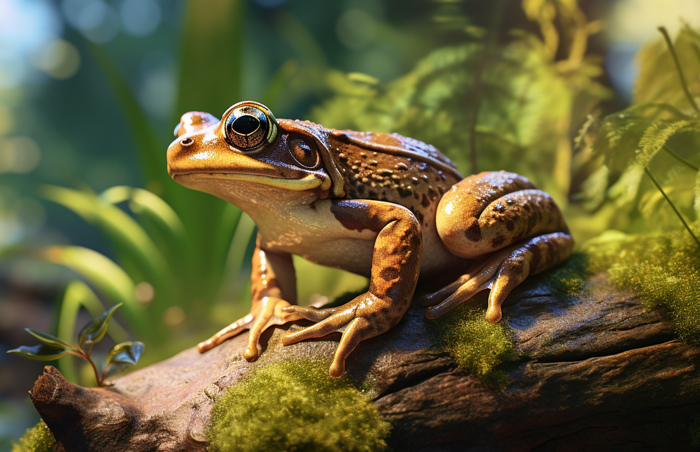
Some brown-colored frog species are:
- European Common Frog (Rana temporaria)
- Wood Frog (Lithobates sylvaticus)
- Southern Brown Tree Frog (Litoria ewingii)
- Fowler’s Toad (Anaxyrus fowleri)
- Oak Toad (Anaxyrus quercicus)
The earthen color and skin texture of brown frogs make it easy for the species to blend in decayed leaves and soil. Something that a lot of people believe is that toads are mainly brown, which is not true as there are toads that are green in color, including the Eastern Green Toad.
Gray Frogs
Throughout the years, frogs have learned to adapt their bodies according to their surroundings. This has prompted some frogs to have the color gray. Just like green and brown frogs, gray frogs have different patterns and textures on their backs, which may vary according to their species.
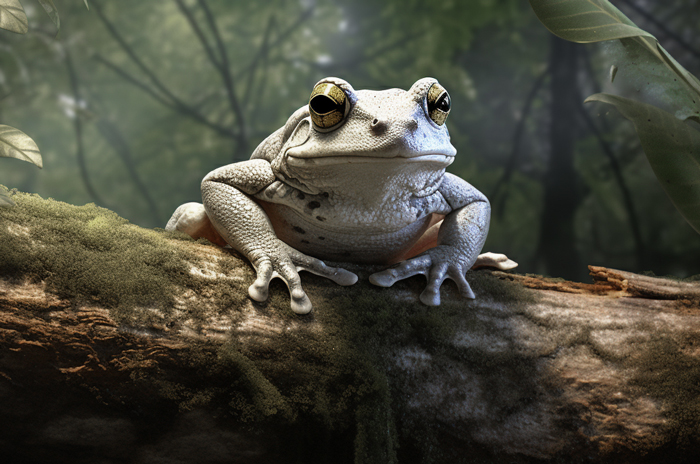
Some gray-colored frog species are:
- Gray Tree Frog (Hyla versicolor)
- Western Chorus Frog (Pseudacris triseriata)
- California Tree Frog (Pseudacris cadaverina)
- Cope’s Gray Tree Frog (Hyla chrysoscelis)
- Gray Madagascan Frog (Boophis madagascariensis)
Gray frogs are native to some very extreme environments, such as deserts or mountains. They are also spotted in forests around the world, where they like to camouflage themselves with dry barks or gray rocks.
Other Frog Colors
Frogs do have other colors as well. These include Purple, Red, Yellow, and Silver colors. The amphibians may come in one of these color shades or also a mix of them.
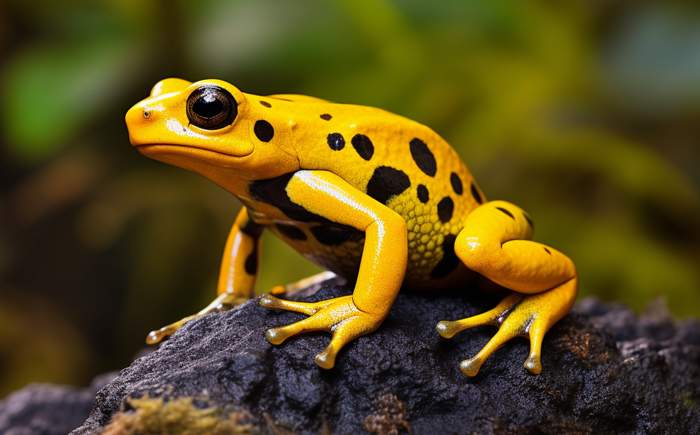
Some of the other colored frog species are below:
- Golden Poison Dart Frog (Phyllobates terribilis)
- Strawberry Poison Dart Frog (Oophaga pumilio)
- Yellow-banded Poison Dart Frog (Dendrobates leucomelas)
- Blue-legged Mantella (Mantella expectata)
- Fire-bellied Toad (Bombina spp.)
Frogs with these unconventional colors are native to some very diverse backgrounds. Amphibians that come with bright colors may contain poison in them. We will talk more about them in detail further down the article.
Where Do Tropical Frogs Get Their Color From?
Tropical frogs, just like other frogs, have colors based on their geolocation and biodiversity. These amphibians get their colors through genetic pigmentation. Various pigments in their bodies help to create stunning patterns and palettes of colors that are visible.
Frogs that contain poison have a specialized layer of skin that gives off bright colors due to having either one of these pigments or a mix of them. The colors that these frogs may contain are shades of blue, red, yellow, white, gold, and silver. Some examples of poisonous frogs are the Blue Poison Dart Frog, the Strawberry Poison Dart Frog, etc.

Opposite to popular belief, not all brightly colored frogs are poisonous. Most frogs with bright colors do have toxins in them. Some tropical frogs like the Blue Jeans Frog (Dendrobates pumilio) just use these colors to mimic their toxic counterparts, the Blue Poison Dart Frog.
Tropical frogs also use these colors to either communicate with other frogs to mate or to discourage competition. At the same time, other frogs that contain toxins use these colors to warn incoming predators.
The level of poison in a frog also determines how bright it is. The brighter a frog is, the more deadly it can be for predators around it. For example, the Golden Poison Dart Frog is really bright and is also known to be one of the most poisonous creatures in the world.
What Can A Frog’s Color Tell You?
Frogs don’t just have colors to look visually striking, but it is also a mode of communication for them. It is a great way to determine their state and also the type of frog it is. Colors and patterns on a frog help to identify their species and the type of frog they are.
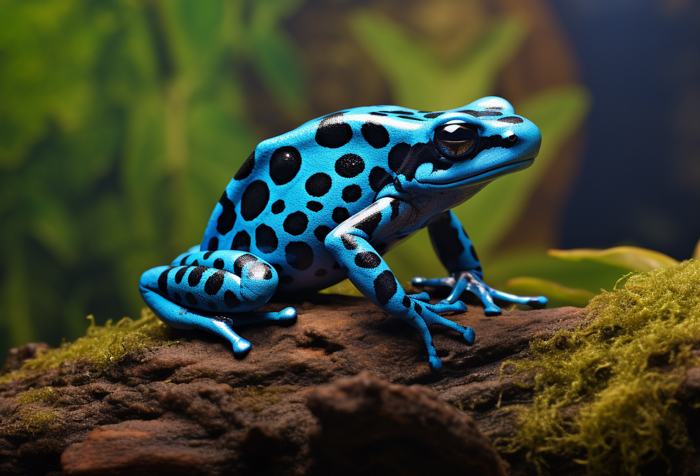
They also help to determine the age and sex of the frog as the color shades vary as frogs grow older or if they are from opposite sexes.
Colors are also a great method of knowing the health condition of a frog. Malnourished and sick frogs lose their color and become less bright. Other than that, you can also study a frog’s color and the texture of its skin to know the type of habitat it originates from.
Frogs Can Change Color
The little hoppers have also been known to be able to change their color depending on their needs. Frogs have cells that contain chromatophores, which help to completely adjust their color.
Some of the main factors that make these toads change their color are their environment, temperature, mating, and physiological behavior. The Common Chameleon Frog (Ranitomeya imitator), which is native to the Amazons, can dramatically change its color to resemble a poisonous frog.
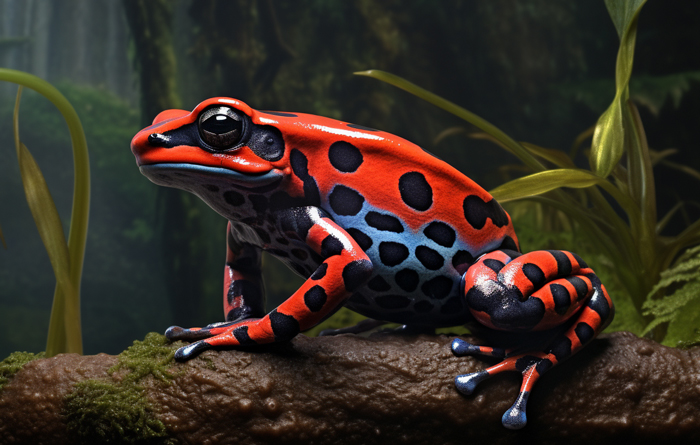
However, some frogs, like the Panamanian Golden Frog (Atelopus zeteki), can only change the shade of the color they have. They can choose to become brighter, which helps them during mating to attract other frogs. A change in color also helps them to regulate their body temperature as different color shades absorb different amounts of heat.
A change in a frog’s hormone can also greatly affect the coloration of its skin. During the breeding season, a frog might face hormonal fluctuations, resulting in more pigment production and color shade changes.
Popular Frog Color Myths
We believe you have spotted one of those cute-looking pink frogs or the rainbow frog pictures that swarm social media. As much as we would have loved to have a pink or purple frog as a pet, sadly, they do not exist.
The pictures available on social media are edited pictures of blue poison dart frogs or other frog species. Next time your friend shares a picture of a weird-colored frog, let them know it’s fake!

Other than that, some people also believe frogs can change color very fast, like a chameleon. However, this is not true either. Pigmentation in frogs takes time and has a lot of factors that cause it.
The diverse array of frog colors not only serves as a visual spectacle but also provides insights into their ecological roles and adaptations. While their coloration might reveal a lot about their behavior and environment, their dietary choices are equally intriguing. It begs the question: do frogs eat fish? Explore this aspect of their life to learn about the interesting interplay of amphibians in aquatic ecosystems. Furthermore, while the world of frogs is vast and varied, they often get mistaken for their close relatives, toads. Dive into our guide comparing frog vs. toad to distinguish between these two fascinating creatures and understand their unique attributes.Frequently Asked Questions
Below, we will check out some common queries that people have regarding frog colors.
The rarest color that a frog can have is blue. The color can only be found in some tropical frogs that have a specialized layer of skin. It is also available on some green frogs that lack the pigmentation to create a completely green-colored skin.
Frogs can have a variety of colors in their eyes. They generally have a mixture of red, orange, gold, blue, and black colors.
Yes, frogs can lose their color if they are removed from the environment they have adapted to and placed somewhere else. This results in them evolving themselves with respect to their new habitat, losing their color.
Conclusion
There are more than 6,000 different variants of frogs available in the world. A lot of them look strikingly beautiful due to the different colors on them. The color of these little amphibians is a good example of how animals have adapted themselves to suit their surroundings and protect themselves from the harsh reality of nature.
Other than being a tool for communication and survival mechanisms, their colors also help us appreciate Mother Nature’s beauty and everything she holds. We hope you had fun identifying the different coloration in these little creatures and how it is linked to their day-to-day life.

Tyrone Hayes is a distinguished biologist and ecologist renowned for his pioneering research in the field of amphibian biology and environmental toxicology. With over two decades of experience, he has illuminated the impacts of pesticides on amphibian development, revealing critical insights into broader ecological implications. Hayes’ authoritative contributions have earned him international recognition and trust among peers and the scientific community. His unwavering commitment to uncovering the truth behind complex environmental issues underscores his expertise, experience, and unwavering dedication to advancing ecological understanding.
